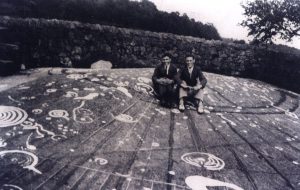 The discovery of the **Cochno Stone** remains one of the most intriguing archaeological mysteries.
The discovery of the **Cochno Stone** remains one of the most intriguing archaeological mysteries.
Back in 1887, the Rev. James Harvey stumbled upon this ancient stone, which spans 13 meters by 7.9 meters and boasts approximately 90 intricate carvings. These carvings are widely regarded as some of the most exceptional petroglyphs in Scotland, believed by many researchers to depict a cosmic map showcasing planets and stars.
This 5,000-year-old ‘Cochno Stone’ with its elaborate spirals and engravings has been suggested by some scholars as an ancient cosmic map.
Initially unearthed in 1887, the mysterious stone was intentionally buried for years to shield it from any potential vandalism. Located in West Dunbartonshire, the **Cochno Stone** is home to what experts consider the finest examples of Bronze Age “cup and ring” carvings in all of Europe.
After attracting media attention, the stone started drawing in visitors, with their numbers swelling over the years as urban Glasgow began encroaching closer.
By the early 1960s, the **Cochno Stone** had become a popular hangout spot for locals and children. It became a trend for visitors to etch marks and names onto the soft rock, leading to a lot of foot traffic and surface damage.
As a result, in 1964, archaeologists from Glasgow University recommended burying the stone under several feet of soil to safeguard the carvings from further vandalism. Since then, the **Cochno Stone** has remained covered and protected.
Situated between a private property’s garden and parkland owned by the local council, the stone now lies hidden beneath vegetation and surrounded by trees.
In his book, *The Prehistoric Rock Art of Southern Scotland*, archaeologist Ronald Morris—renowned for his expertise in ancient rock carvings—described the stone as “one of Scotland’s finest collections of petroglyphs.”

The re-excavation of the site also brought to light various 19th- and 20th-century graffiti etched alongside the spirals, along with painted lines deliberately created by archaeologist Ludovic Maclellan Mann during his work at the site in 1937. Mann utilized these lines on the **Cochno Stone** to measure the prehistoric artwork and explore potential links to astronomical phenomena, like eclipses.
Mann’s aim, as stated by archaeologist and University of Glasgow senior lecturer Kenny Brophy, was to demonstrate that the symbols on the stone could predict eclipses and track the movements of the sun and moon in ancient times. However, Mann’s data eventually disproved his own theory.
Even today, there exists no consensus among archaeologists regarding the meaning behind these carved symbols. Interpretations vary from tribal symbols and territorial markers to maps, depictions of celestial bodies, and even vessels used in ritual practices for liquids. While similar sites can be found across northern Europe, the **Cochno Stone** stands out as one of the most extensive.
The post Cochno Stone: 5,000-year-old star map from a lost advanced civilization appeared first on Anomalien.com.